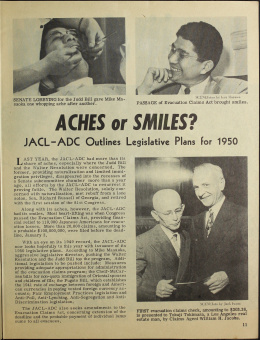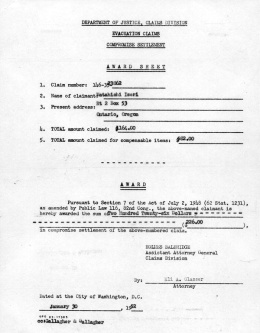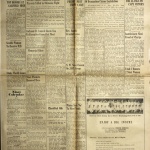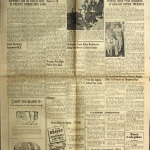Japanese American Evacuation Claims Act
The Japanese American Evacuation Claims Act, signed into law by President Harry S. Truman in 1948, provided a mechanism to compensate Japanese Americans for losses incurred at the time of their official removal from the West Coast in 1942. Enacted by Congress in a period of changing perceptions of Japanese Americans and their wartime confinement, it was the first civil rights-associated law enacted in the 20th century. However, the legislation proved largely ineffectual in practical terms due to onerous burdens for proving losses and red tape that slowed the process to a crawl.
Background
The origins of the Evacuation Claims law are diverse. As far back as spring 1942, the Tolan Committee recommended some sort of remedial legislation. During the war various supporters of Japanese Americans, notably Socialist leader Norman Thomas and African American journalist George Schuyler, publicly advocated compensation for the inmates. However, the government was slow to consider any such measure. When the Women's International League for Peace and Freedom informed Dillon Myer in September 1945 of its resolution calling for reparations for property losses, Myer responded that the War Relocation Authority (WRA) had no authority to implement such a measure and Congress had shown no interest. Myer privately favored such a measure, however, and during the latter half of 1945, he lobbied his Interior Department superiors to press for action. Interior Secretary Harold Ickes expressed his support, but was unable to persuade other administration officials to join him.
After Ickes resigned from the Cabinet in February 1946, Undersecretary Oscar Chapman took temporary control of the Interior Department. Under Chapman's leadership, Department lawyers joined WRA staffers to design a property compensation bill. The bill provided for the establishment of a three-person Evacuation Claims Commission within the Interior Department that would adjudicate claims for personal property or assets that arose from the "evacuation and exclusion programs." In April 1946, the Interior Department officially submitted the bill to Congress. It was not expansive in its provisions. As Julius Krug, the newly appointed Secretary of the Interior, explained in his cover letter, "The standard excludes claims that are largely speculative and less definitely appraisable, such as claims for anticipated wages or profits that might have accrued had not the evacuation occurred, for deterioration of skills and earning capacity, and for physical hardships of mental suffering." [1] In addition to these limitations, a cap of $2,500, including payment for attorney's fees, was placed on awards. In July 1946 (immediately after a well-publicized visit to the White House by members of the 442nd Regimental Combat Team ) Truman sent public letters to the heads of the Senate and House Judiciary Committees urging passage of the Evacuation Claims bill. Despite this endorsement, California Democrats who feared that passage would harm them in the November 1946 elections killed the bill.
In the November 1946 elections, the Republicans took control of both houses of Congress. Realizing that White House strategists needed outside aid, the Japanese American Citizens League 's new Anti-Discrimination Committee undertook a new campaign. In late January 1947, JACL lobbyist Mike Masaoka met at the White House with David Niles and Philleo Nash, Truman's "minority group" liaisons. Masaoka proposed a new approach, recommending that the government provide a lump sum payment of $1,000 to each "evacuee" and then make provision for litigation in the Court of Claims for any sums over that provided. Such liberalization, Masaoka said, would be fairer and "would save both the evacuees and the government a lot of time and money." [2] If such a lump sum payment were not possible, Masaoka proposed that at least certain intangible losses such as good will and lost wages be recoverable. [3] Niles and Nash responded that such provisions would wreck any possible chance of the existing bill's passage and alienate government officials. Dillon Myer publicly expressed repeated support for claims, but strong opposition to an "indemnity."
Compromise and Consolidating Support
Such opposition led to an impasse. Many JACL supporters continued to support a lump sum payment, expressing skepticism that a "claims" bill would actually benefit Japanese Americans. Masaoka ultimately consulted former Attorney General Francis Biddle . Biddle responded that since the Supreme Court had upheld the original removal in the Korematsu case, the JACL had little case against the government in legal terms. Masaoka told his colleagues that "pots and pans money" was about all that could be expected. [4] Nonetheless, he argued that it was worth it to help impoverished Issei and Nisei recover some money.
The evacuation claims bill was reintroduced in spring 1947 as H.R. 3999. While it was largely identical to the previous bill, the attorney general was now made adjudicator of all evacuation claims. The bill's supporters organized a round of Congressional hearings. The star witness was Dillon Myer, who deplored removal as unjustified and racially motivated. The House Committee issued a report strongly favoring the bill, and on July 24, 1947, the House approved H.R. 3999 without a dissenting vote. However, because Senate leaders wished to hold their own hearings, and to question the attorney general on the manner in which claims investigations would be made, the bill was held over until 1948. [5]
Meanwhile, Masaoka appeared before the President's Committee on Civil Rights, which had been appointed by Truman to report on racial discrimination, in order to discuss bias against Japanese Americans. In October 1947 the Committee issued its landmark report, To Secure These Rights . Although it focused on Black Americans, the report forthrightly denounced the "evacuation and exclusion of persons of Japanese descent" as "the most striking mass interference since slavery with the right to physical freedom" and called for a federal commission to inquire into the entire matter. [6] The committee report further recommended ending anti-Asian discrimination in immigration and naturalization laws, urged the abolition of alien land laws and other racist legislation, and recommended property claims legislation. As the report stated, "The government has acknowledged many Japanese Americans evacuees suffered considerable losses though its actions and through no fault of their own. We cannot erase all the scars of evacuation; we can reimburse those who present valid claims for material losses." [7]
The Committee's report helped bring the demands of Japanese Americans to a primary place in administration concerns. In early February 1948, President Truman sent his civil rights message to Congress. In its text, the President stated:
During the last war more than 100,000 Japanese-Americans were evacuated from their homes in the Pacific states solely because of their racial origin. Many of these people suffered property and business losses as a result of this forced evacuation and through no fault of their own. The Congress has before it legislation establishing a procedure by which claims based upon these losses can be promptly considered and settled. I trust that favorable action on this legislation will soon be taken." [8]
In March 1948, Senate hearings began on the bill. Chapman and Masaoka mobilized a parade of witnesses to testify in favor of the bill, most notably former Assistant Secretary of War John McCloy . McCloy in turn told the Senators that his former boss, the retired Secretary of War Henry Stimson , had authorized him to state Stimson's opinion that the bill was a "just obligation."
Passage and Impact
On June 2, 1948, following passage in the Senate, President Truman signed the Evacuation Claims bill into law. It provided up to $25 million to compensate Japanese Americans for actual losses pursuant to their "evacuation." As the only item of President Truman's civil rights program to be passed by Congress, the Act represented a pioneering civil rights bill. Nevertheless, as Masaoka himself later put it, "The victory turned out to be only a partial one, and a costly and vital learning experience in dealing with the feds." [9] In order to secure easier passage, the JACL had accepted a government-drafted bill with glaring weaknesses. First, Washington did not officially admit wrongdoing or violation of civil rights. Those Japanese Americans who wished to recoup losses were forced to swear that this was their sole and final claim against the government for their wartime ordeal. Congress refused to settle claims for lost wages or anticipated profits, personal injury, pain and suffering, or any of the other costs of removal and confinement. Even the procedure instituted for allowable claims under the Act was exceedingly harsh. The former inmates were in required to provide sworn testimony and to produce receipts and other proofs of their losses. If their claim amounted to over $2,500, they were required in effect to sue the government for damages, and await fresh appropriation of funds to pay claims. The Justice Department strongly contested each claim, using a legalistic definition of what could be counted as a "loss."
Japanese Americans filed a total of 23,689 claims under the Act, for an aggregate amount of $131,949,176. Some 40% of claims (8,696) were for over $2,500. By 1950, the Department had heard barely 200 claims of the 23,000 filed, and authorized only 137. Masaoka was able to speed up the process by arranging passage of an amendment to the Act that permitted claimants to arrange a compromise settlement of the lesser of $2,500 or three-quarters of the amount sought. Another amendment, enacted in 1956, allowed the attorney general to settle all claims up to $100,000 (that is, all remaining claims, with a single exception) and permitted Japanese aliens interned in Justice Department Camps to file claims. Still, the last claim was not settled until 1965. In all, the government paid $38 million to settle damage claims—a fraction of actual losses by Japanese Americans. Many families paid more in lawyer's fees than they received in compensation.
In a sense, the Evacuation Claims Act resembled many government actions taken during the war. Although meant to atone for wrongs and aid the Japanese Americans, it ended by bringing misery to many of those affected. It was not until 40 years later that a meaningful redress bill was enacted.
For More Information
Chuman, Frank F. The Bamboo People: The Law and Japanese-Americans . Del Mar, Calif.: Publisher's Inc., 1976.
Nakasone-Huey, Nancy N. "In Simple Justice: The Japanese-American Evacuation Claims Act of 1948." Dissertation, University of Southern California, 1986.
Robinson, Greg. A Tragedy of Democracy: Japanese Confinement in North America . New York: Columbia University Press, 2009.
Footnotes
- ↑ Letter, Julius Krug to Samuel Rayburn, April 24, 1946. Dillon Myer files, Harry S. Truman Library, Independence, Missouri.
- ↑ "Mike Masaoka Reviews Nisei Problems in Conference With White House Representative," Pacific Citizen , Jan. 25, 1947, 1.
- ↑ "Propose $1000 a Head Straight 'Claims Bill'," Rafu Shimpo , Jan. 25, 1947, 1.
- ↑ Mike Masaoka, progress report to JACL, January 17, 1948. Civil Rights Files, Mike Masaoka Papers, Marriott Library, University of Utah.
- ↑ "Senate Tables Claims Bill Until next Session of Congress," Utah Nippo , Aug. 1, 1947.
- ↑ U.S. Government, President's Committee on Civil Rights, To Secure These Rights: Report of the President's Committee on Civil Rights (Washington DC, Government Printing Office, 1947), 30-31.
- ↑ To Secure These Rights , 158-59.
- ↑ Harry Truman, Special Message to the Congress on Civil Rights, February 2, 1948, in Public Papers of the Presidents of the United States: Harry Truman: Containing the Public Messages, Speeches and Statements of the President: Vol. 3, 1948 (Washington D.C. Government Printing Office, 1966), 121.
- ↑ Mike Masaoka and Bill Hosokawa, They Call Me Moses Masaoka (New York: William Morrow, 1987), 207.
Last updated Oct. 5, 2020, 6:29 p.m..

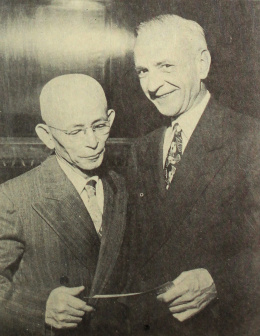 Media
Media
